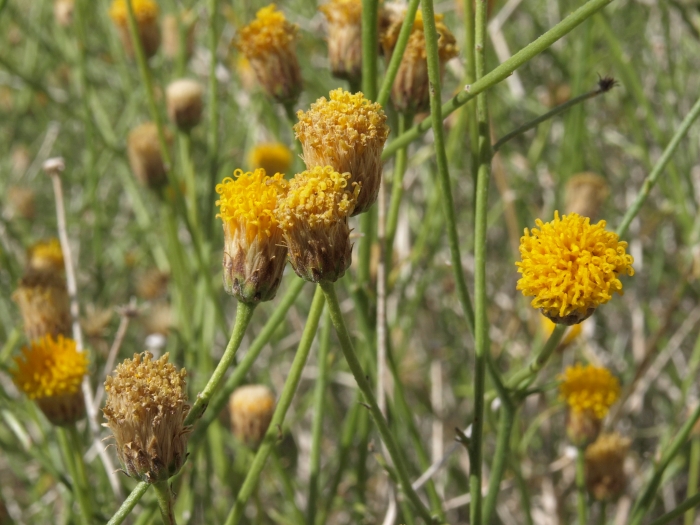Rough Sweetbush
(Bebbia juncea var. aspera)
Rough Sweetbush (Bebbia juncea var. aspera)
/
/

Jim Morefield
CC BY-SA 2.0
Image By:
Jim Morefield
Recorded By:
Copyright:
CC BY-SA 2.0
Copyright Notice:
Photo by: Jim Morefield | License Type: CC BY-SA 2.0 | License URL: https://creativecommons.org/licenses/by-sa/2.0/ | Uploader: Jim Morefield | Publisher: Flickr |



















































Estimated Native Range
Summary
Bebbia juncea var. aspera, commonly known as Rough Sweetbush, is a deciduous shrub or subshrub native to arid desert washes, rocky slopes, and scrublands of the Southwestern United States, as well as California, as well as Northwest Mexico. It typically grows to a height of 3-4 feet (0.9-1.2 meters) and spreads to about 3 feet (0.9 meters) wide. The plant has a distinctive form with wiry, slender stems and small, narrow leaves that help conserve water. Rough Sweetbush produces small, inconspicuous yellow and orange flowers that bloom sporadically throughout the year, with peaks in the spring and fall. These flowers are not particularly showy but are attractive to pollinators such as bees.
Rough Sweetbush is valued for its drought tolerance and ability to thrive in harsh, dry conditions, making it an excellent choice for xeriscaping and naturalistic plantings in arid regions. It is also used for erosion control on slopes and in restoration projects. In cultivation, it requires minimal maintenance, preferring full sun exposure and soils with excellent drainage. While it tolerates low water conditions, occasional deep watering during prolonged dry periods can help maintain its vigor. There are no major disease or pest issues associated with this plant, but it should not be overwatered as it is adapted to dry environments.CC BY-SA 4.0
Rough Sweetbush is valued for its drought tolerance and ability to thrive in harsh, dry conditions, making it an excellent choice for xeriscaping and naturalistic plantings in arid regions. It is also used for erosion control on slopes and in restoration projects. In cultivation, it requires minimal maintenance, preferring full sun exposure and soils with excellent drainage. While it tolerates low water conditions, occasional deep watering during prolonged dry periods can help maintain its vigor. There are no major disease or pest issues associated with this plant, but it should not be overwatered as it is adapted to dry environments.CC BY-SA 4.0
Plant Description
- Plant Type: Shrub, Subshrub
- Height: 3-4 feet
- Width: 2-3 feet
- Growth Rate: Moderate
- Flower Color: N/A
- Flowering Season: Spring, Summer, Fall
- Leaf Retention: Deciduous
Growth Requirements
- Sun: Full Sun
- Water: Low, Medium
- Drainage: Fast
Common Uses
Low Maintenance, Rock Garden
Natural Habitat
native to arid desert washes, rocky slopes, and scrublands of the Southwestern United States, as well as California, as well as Northwest Mexico
Other Names
Common Names: Bebbia, Sweetbush
Scientific Names: , Bebbia juncea var. aspera, Bebbia aspera,
GBIF Accepted Name: Bebbia juncea var. aspera Greene